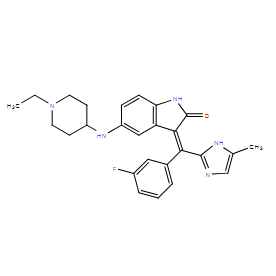| Cas No.: | 705946-27-6 |
| Synonyms: | XL999,XL 999 |
| SMILES: | O=C1NC2=C(C=C(NC3CCN(CC)CC3)C=C2)/C1=C(C4=CC=CC(F)=C4)/C5=NC=C(C)N5 |
| Formula: | C26H28FN5O |
| M.Wt: | 445.22 |
| Purity: | >98% |
| Sotrage: | 2 years -20°C Powder, 2 weeks4°C in DMSO,6 months-80°C in DMSO |
| Description: | XL-999(Tyrosine kinase-IN-1) is a multi-targeted tyrosine kinase inhibitor with IC50s of 4, 20, 4, 2 nM for KDR, Flt-1, FGFR1 and PDGFRα, respectively. |
| Target: | Flt-1:4 nM (IC50) KDR:20 nM (IC50) PDGFRα:4 nM (IC50) FGFR1:2 nM (IC50) |
| In Vivo: | Tyrosine kinase-IN-1 shows a reasonable PK profile (AUC(0–∞)=1.9, t1/2=4.6 h). It has a favorable oral bioavailability (F=63%) in rats[1]. |
| In Vitro: | Tyrosine kinase-IN-1 is from reference (compound 8K)[1]. |
| Kinase Assay: | Kinase Inhibition Assays Kinase activities of KDR and PDGFRα are measured as the percent of ATP consumed following the kinase reaction using luciferaseluciferin-coupled chemiluminescence. Kinase reactions are initiated by combining test compound (Tyrosine kinase-IN-1), ATP, kinases and substrates in a 20 mL volume using 384-well microtiter plates. For KDR, the final reaction mixture contained 3 mM ATP, 1.6 mM poly(Glu, Tyr) 4:1 and 1.5 nM KDR of residues D807-V1356 with an N-terminal GST tag. For PDGFRα, the final reaction mixture contained 2 mM ATP, 10 mM MBP and 14 nM PDGFRα of residues Q551-L1089 with an N-terminal GST tag. The reaction mixture is incubated at room temperature for 4 h (KDR) or 2 h PDGFRα before a 20 mL aliquot of Kinase Glo is added and luminescence signal is measured using a Victor2 plate reader. Total ATP consumption is limited below 50%[1]. |
| References: | [1]. Moon K, et al. The design, synthesis, and biological evaluation of potent receptor tyrosine kinase inhibitors. Bioorganic & Medicinal Chemistry Letters 22 (2012) 4979–4985 |

 To enhance service speed and avoid tariff delays, we've opened a US warehouse. All US orders ship directly from our US facility.
To enhance service speed and avoid tariff delays, we've opened a US warehouse. All US orders ship directly from our US facility.




















